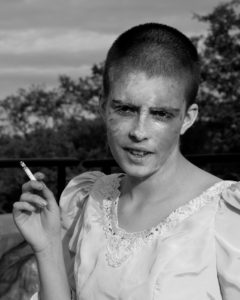In all forms of art lies a space between what the creator of the art intends and what the viewer of the art perceives. Camosun second-year Visual Arts student Nina Parrotta—who was awarded the Camosun Van den Brink Residency, given to a second-year Visual Arts student, this year—intends to narrow that space down through her chosen medium of film photography.
Film is regarded as the old-fashioned form of photography: those who shoot in film can’t see the photos until after they’re developed. Also, there are far fewer exposures to work with than in digital photography, and for Parrotta, that’s a main part of the appeal.
“I’ve never really connected with digital photography at all. My whole life, I thought that I just wasn’t a photographer until I picked up a film camera and it just completely changed my world around,” says Parrotta, referring to “the idea of setting up a shot to capture a moment in time or the essence of a person, as closely as possible, and sort of building the representation of someone through the most accurate method you can.”
Parrotta has worked a little bit with painting and watercolour as well, but she found that she quickly retreated to her comfort zone of photography.
“Painting and watercolour’s interesting in the sense that you can still sort of capture what the person’s about,” she says, “but photography has always sort of been regarded as the most truthful medium.”
For Parrotta, that’s an interesting axiom to work close to, because, she says, it has been proven time and time again to “not really be that truthful.”
“There’s just something really interesting about that, especially nowadays, when you can do anything with a camera,” she says. “You can do as much with a camera as you can with a paintbrush.”
Parrotta strives to balance the natural manipulation of reality with the organic truth she finds in front of the lens. When she uses film, it naturally narrows the inevitable gap between photo and reality. Most people use digital cameras, but even what’s in the viewfinder of the camera—unedited, untouched—“is still not going to be reality, in a way,” she says.
“You can always cut something out, you know?” she says, adding that she has been playing with that concept a lot in portraiture.
With digital photography, there’s no limit to the number of photos you can take in a shoot. In film, there are 24 or 36 exposures to work with, and the person taking the pictures has to physically go develop the film before they can even see what they’ve ended up with.
“Film is almost backwards in the sense that each shot, you have to set up so perfectly, so most of that thought process is before you even take the picture,” she says. “Whereas in digital, after you take the picture, the majority of the work comes into play.”
With film, you have to slow right down and focus on everything before you even take the picture, says Parrotta, and in the fast-paced world we live in, the pace of film photography is the appeal.
“Digital photography, it’s almost like fast fashion to me,” she says. “It’s so quick, and then you always sort of have something that comes out of it. The risk factor is pretty low… You know what you’re going to get if you take the picture, because you can see it.”
Parrotta has had times when she’s spent many hours shooting a roll and then discovered something went wrong with the camera and the entire roll was blank.
“At the end of the day it’s a lot riskier,” says Parrotta, “and I personally like that, because I feel more connected to each picture.”
But there are situations where Parrotta has to shoot digital, because digital cameras can do some things that the older film ones can’t, she says.
“I’ll edit the digital photos, but otherwise, with film, I do very minimal editing,” she says. “I’ll colour correct, sharpen it; a lot of times when you scan negatives to a really high resolution they come up as dust particles that have just gotten their way into the scanner, and I’ll edit those out. I like to keep the colour as authentic as possible, so I try to keep [the editing] to a bare minimum.”
Parrotta is focusing mainly on portraiture during the Van den Brink Residency, because that style interests her the most.
“I just can’t think of anything I’d like to photograph more than the people around me,” she says. “I mostly photograph people who I know pretty well; I’m comfortable with them, and they’re comfortable with me.”
During the portrait shoots, which are typically done with her friends as subjects, it’s about getting photos that display the essence of the subject so vividly that even a complete stranger could see it.
“There’s always going to be a spectrum of what the viewer’s going to interpret, as opposed to what the artist’s intention was,” she says. “What your intention was with the artwork is never going to be exactly what every single person’s going to take away from it. I love my friends and I want everybody to catch a glimpse of what it’s like to know them in one photo.”
And recently, Parrott has been expanding her horizons and collaborating with people she doesn’t know.
“Sometimes there’s an organic quality to the first time meeting someone and taking their picture that you can’t recreate,” she says, “and sometimes that creates something really beautiful.”

